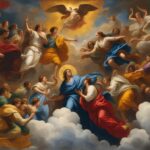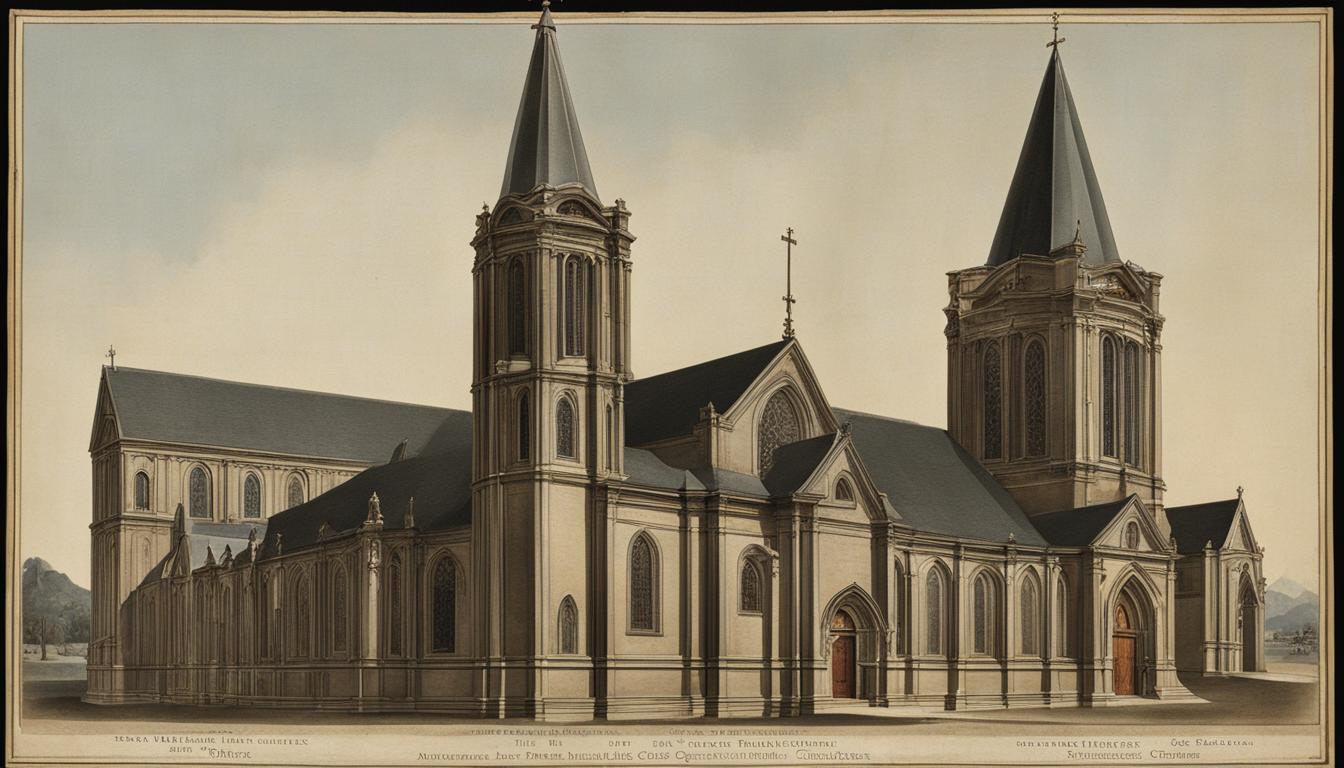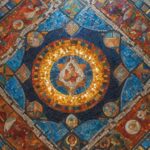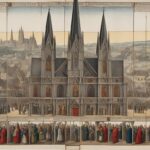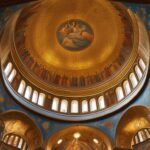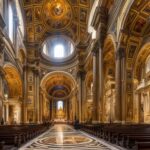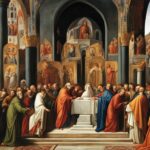The history of the Catholic Church spans 2,000 years and has had a profound impact on Western civilization. One of the significant aspects of this history is the series of ecumenical councils that have taken place throughout the centuries. These councils, known as the Major Early Church Councils, have played a pivotal role in shaping the teachings and doctrines of the Church.
Understanding the historical significance of these councils is crucial to grasping the development and beliefs of the Catholic Church. From addressing heresies to clarifying theological controversies, these councils have left an indelible mark on contemporary Christianity.
In this in-depth analysis, we will delve into the major early Church councils and explore their impact on contemporary Christianity. Through a comprehensive examination of each council, we will discover the historical context, the key issues addressed, and the lasting effects on the Church.
Key Takeaways:
- The Major Early Church Councils have shaped the teachings and doctrines of the Catholic Church.
- These councils played a pivotal role in addressing heresies and clarifying theological controversies.
- The decisions of these councils continue to impact contemporary Christianity.
- Understanding the historical significance of these councils provides insights into the development of the Church.
- The beliefs and teachings of the Catholic Church are deeply intertwined with the outcomes of these councils.
The Council of Nicaea (325)
The Council of Nicaea, held in 325, was a crucial event in early Church history. It was called to address the heresy of Arianism, which denied the divinity of Christ. Led by Emperor Constantine, over 300 bishops gathered to deliberate on this significant theological issue. The council condemned Arianism and established the orthodox belief in the divinity of Christ.
One of the enduring outcomes of the Council of Nicaea is the formulation of the Nicene Creed. This creed succinctly expresses the foundational beliefs of Christianity and is recited in Mass and other Christian liturgies. It affirms the divinity of Christ, his consubstantiality (being of the same substance) with the Father, and the role of the Holy Spirit in the life of the Church.
“We believe in one God, the Father Almighty, maker of heaven and earth, of all things visible and invisible. And in one Lord Jesus Christ, the only begotten Son of God, begotten of the Father before all ages…”
– Excerpt from the Nicene Creed
Table: Comparison of Arianism and Orthodox Beliefs
| Arianism | Orthodox Beliefs | |
|---|---|---|
| Divinity of Christ | Christ is a created being and not co-eternal with the Father. | Christ is fully divine and co-eternal with the Father. |
| Substance | Christ is of a different substance (homoiousios) than the Father. | Christ is of the same substance (homoousios) as the Father. |
| Salvation | Salvation is achieved through following the teachings of Christ. | Salvation is achieved through faith in Christ’s atoning sacrifice. |
The Council of Nicaea laid the foundation for future ecumenical councils and set the precedent for resolving theological disputes through authoritative decisions. Its impact can still be felt in contemporary Christianity, as the teachings and doctrines established at Nicaea continue to shape the beliefs of millions of Christians worldwide.
The First Council of Constantinople (381)
The First Council of Constantinople, held in 381, was a pivotal event in the history of the early Church. This council aimed to clarify the nature of the Holy Trinity and further develop the teachings established at the Council of Nicaea in 325. The council’s discussions revolved around the divinity of the Holy Spirit and resulted in the revision of the Nicene Creed, which now includes explicit statements about the Holy Spirit. The First Council of Constantinople solidified the Church’s understanding of the Holy Trinity and affirmed the role of the Holy Spirit within the Godhead.
Table: Key Decisions of the First Council of Constantinople
| Decisions | Explanation |
|---|---|
| Revised Nicene Creed | The council expanded the Nicene Creed to include explicit statements about the Holy Spirit, underscoring the divinity of each person in the Godhead. |
| Clarified the nature of the Holy Trinity | The council reaffirmed the conclusions of the Council of Nicaea and emphasized the divinity of the Holy Spirit, highlighting the equal importance of each person in the Godhead. |
| Declared the Holy Spirit’s role | The council affirmed the Holy Spirit’s role in the life of the Church and its members, emphasizing its sanctifying and empowering presence. |
The First Council of Constantinople played a crucial role in shaping the Church’s understanding of the Holy Trinity. By further elaborating on the divinity of the Holy Spirit and revising the Nicene Creed, the council solidified key theological beliefs that continue to be central to contemporary Christianity. The council’s decisions ensured clarity in the Church’s teachings and provided a foundation for further theological development in the centuries to come.
“The First Council of Constantinople was instrumental in defining the nature of the Holy Trinity and solidifying the Church’s understanding of the divinity of the Holy Spirit. Its revisions to the Nicene Creed reaffirmed the equal importance of each person within the Godhead.”– The Early Church Historian
The Council of Ephesus (431)
The Council of Ephesus, one of the major early Church councils, convened in 431 to address the heresy of Nestorianism. Nestorianism taught that there were two separate persons within Christ, one divine and one human, rather than the unity of His divine and human natures. The council condemned Nestorianism and affirmed the belief in the hypostatic union of Christ’s natures. This means that Jesus is fully God and fully human, with these natures united in one person.
One of the key outcomes of the Council of Ephesus was the affirmation of the title of Mary as Theotokos, which means “Mother of God” in Greek. This title emphasizes the role of Mary as the mother of Jesus, who is both fully divine and fully human. By affirming her as Theotokos, the council reinforced the unity of Christ’s divine and human natures and affirmed the importance of Mary in the mystery of the Incarnation.
“The Council of Ephesus played a crucial role in shaping the understanding of Christ’s nature and the role of Mary in the early Church.”
The teachings and decisions of the Council of Ephesus continue to have a significant impact on contemporary Christianity. The recognition of Mary as Theotokos has endured throughout the centuries and is an important aspect of Marian devotion in both Catholic and Orthodox traditions. Additionally, the affirmation of the hypostatic union contributes to the understanding of Christ’s saving work and the belief in the Incarnation as the means of redemption.
| Key Points | Impact |
|---|---|
| Condemnation of Nestorianism | Established the belief in the hypostatic union of Christ’s natures |
| Recognition of Mary as Theotokos | Emphasized the unity of Christ’s divine and human natures |
| Continued influence on contemporary Christianity | Contributed to Marian devotion and understanding of Christ’s redemptive work |
The Council of Chalcedon (451)
The Council of Chalcedon, held in 451, was a significant ecumenical council in the early history of the Catholic Church. It was convened to address the nature of Christ and the union of His divine and human natures. The council played a crucial role in defining orthodox Christology and establishing the doctrine of the hypostatic union.
The discussions at the Council of Chalcedon centered around the teachings of various theologians, including Eutyches and Nestorius. Eutyches emphasized the unity of Christ’s nature, while Nestorius emphasized the distinction between His divine and human natures. The council sought to find a balance between these positions, affirming that Christ is fully divine and fully human in one person.
The resulting definition of the hypostatic union proclaimed that Christ has two natures, divine and human, which are united in His one person without confusion, mixture, or separation. This declaration became a cornerstone of orthodox Christian theology and continues to shape the beliefs of the Catholic Church and many other Christian traditions.
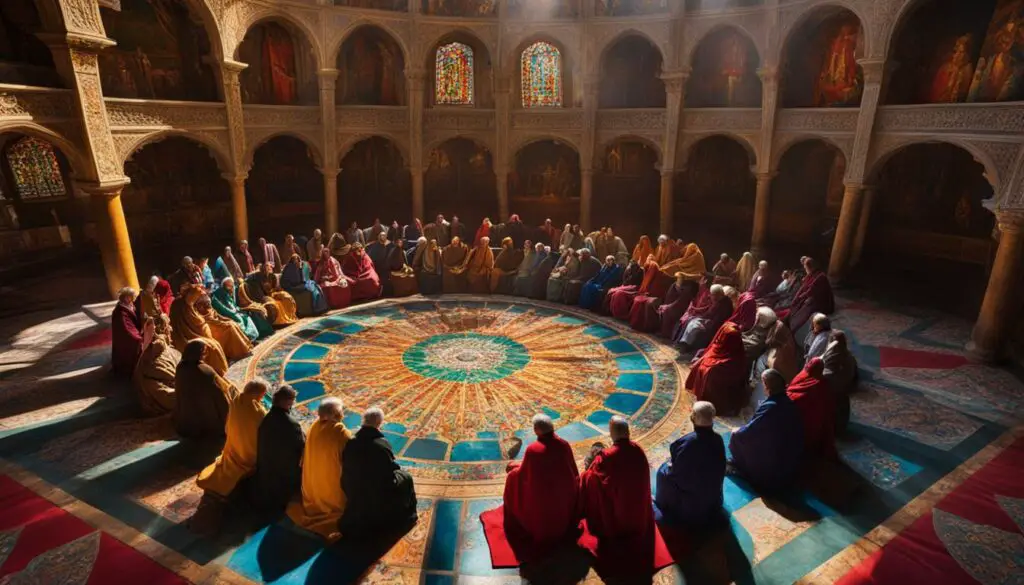
The Definition of the Hypostatic Union
“We, then, following the holy Fathers, all with one consent, teach men to confess one and the same Son, our Lord Jesus Christ, the same perfect in Godhead and also perfect in manhood; truly God and truly man, of a reasonable [rational] soul and body; consubstantial [coessential] with the Father according to the Godhead, and consubstantial with us according to the Manhood; in all things like unto us, without sin; begotten before all ages of the Father according to the Godhead, and in these latter days, for us and for our salvation, born of the Virgin Mary, the Mother of God, according to the Manhood; one and the same Christ, Son, Lord, only begotten, to be acknowledged in two natures, inconfusedly, unchangeably, indivisibly, inseparably; the distinction of natures being by no means taken away by the union, but rather the property of each nature being preserved, and concurring in one Person and one Subsistence, not parted or divided into two persons, but one and the same Son..”
The definition of the hypostatic union provided by the Council of Chalcedon has had a profound impact on Christian theology. It affirms the belief in the full divinity and full humanity of Jesus Christ, recognizing His unique and inseparable nature as the Son of God and the Son of Man. This understanding of Christ’s nature continues to shape the understanding of His work of redemption and salvation.
The Council of Chalcedon stands as a significant milestone in the history of the early Church and its theological developments. By defining the hypostatic union, it established a foundation for understanding the mystery of Christ’s nature and His role in the plan of salvation. The teachings of this council continue to be cherished and studied by theologians and believers alike.
The Second Council of Constantinople: Condemning Nestorianism and Theodore of Mopsuestia
The Second Council of Constantinople, held in 553, was a significant ecumenical council that addressed the theological controversies surrounding Nestorianism and the teachings of Theodore of Mopsuestia. Nestorianism, a heretical belief system, denied the unity of Christ’s divine and human natures, asserting that there were two separate persons within Jesus. Theodore of Mopsuestia, an influential theologian, had propagated similar teachings. The council aimed to reaffirm and clarify the orthodox beliefs regarding the nature of Christ.
The council condemned the teachings of Nestorius and Theodore of Mopsuestia, declaring them to be in opposition to the Church’s doctrines. It affirmed that Christ is one person with two natures, fully divine and fully human, united inseparably in the hypostatic union.
“The council’s decision to condemn Nestorianism and Theodore of Mopsuestia played a crucial role in solidifying the Church’s understanding of Christ’s nature. By upholding the belief in the hypostatic union, the Church affirmed the full divinity and full humanity of Christ, emphasizing the inseparable unity of His two natures.”
The Second Council of Constantinople further built upon the teachings of previous councils, such as the Councils of Nicaea and Ephesus, reinforcing the orthodox understanding of Christ’s nature. Its decisions and declarations continue to shape the theological framework of contemporary Christianity, providing a foundation for faith and doctrine.
| Key Points | Significance |
|---|---|
| Condemnation of Nestorianism and Theodore of Mopsuestia | Reaffirmed the Church’s belief in the unity of Christ’s divine and human natures |
| Affirmation of the hypostatic union | Reinforced the understanding that Christ is fully divine and fully human in one person |
| Continuation of the teachings of previous councils | Contributed to the development of orthodox Christian doctrine |
The decisions of the Second Council of Constantinople remain a cornerstone of Christian theology, providing insight into the nature of Christ and influencing the beliefs and practices of believers throughout history.
References
- Cunningham, M. B. (2010). The Ecumenical Councils of the Catholic Church: A History. Liturgical Press.
- Schreck, A. (2008). Catholic Church History from A to Z: An Inspirational Dictionary. Franciscan Media.
The Council of Carthage: Shaping the Canon of Scripture
The Council of Carthage, held in 397, played a significant role in the establishment of the canon of Scripture. During this council, church leaders and scholars convened to determine which books should be included in the Bible and which ones should be excluded. Their decisions had a lasting impact on the formation of the biblical canon that is widely recognized today.
The council had to address various controversies and disagreements regarding the inclusion of certain books in the Bible. One of the key issues was the recognition of books that were considered authoritative and inspired by God. This led to discussions and debates on the authenticity and validity of different texts.
Through careful deliberation and theological examination, the Council of Carthage ultimately established a consensus on the canon of Scripture. The council affirmed the books of the Old Testament, which had already been widely accepted, and confirmed the inclusion of the New Testament books that are now part of the Christian Bible. This decision provided a framework for the teachings and beliefs of the early Church and continues to shape the faith of contemporary Christianity.
The Council of Nicea II (787)
The Council of Nicea II, also known as the Seventh Ecumenical Council, was a significant event in the history of the Catholic Church. This council was convened to address the issue of iconoclasm, which was the rejection of the veneration of religious icons. The controversy surrounding the use of icons had caused division within the Church, and the council aimed to bring about unity and clarity on this matter.
The council affirmed the use of icons as a legitimate form of Christian worship, emphasizing their role in facilitating devotion and serving as aids to contemplation and spiritual growth. It proclaimed that the veneration of icons should not be mistaken for idolatry, as the honor and reverence given to the images were directed towards the person or divine reality they represented rather than the physical object itself.
“We, therefore, define with all accuracy and diligence that the sacred and venerable images, like the book of the Gospels and the other holy objects of worship, should be placed and expose\[d\] so that the people may be brought to remember and venerate the Incarnation and Passion of our Lord Jesus Christ, and His saving and vmis\[sic\] and Life-giving Death, His ascent into Heaven and His glorious Second Coming, and the veneration and invocation of the Saints, and the resurrection of the dead and the judgement and the reward of the righteousness and the punishment of sinners.”
– Council of Nicea II
By affirming the use of icons, the Council of Nicea II played a crucial role in shaping the practices and traditions of the Catholic Church. It provided a theological foundation for the veneration of icons, highlighting their spiritual significance and the role they played in connecting believers with the divine.
| Iconoclasm | Veneration of Icons |
|---|---|
| Rejects the use of religious icons | Embraces the use of religious icons |
| Views icons as idols and a form of idolatry | Recognizes icons as aids to devotion and contemplation |
| Divided the Church | Promoted unity and clarity within the Church |
The Council of Nicea II’s affirmation of the veneration of icons continues to impact the Catholic Church today. Icons play a prominent role in Catholic worship, serving as visual representations of the divine and sources of spiritual inspiration for believers. The council’s decisions not only resolved a theological controversy but also deepened the understanding of Christian worship and the role of visual imagery in the spiritual life of believers.
![]()
The Council of Lyon (1274)
The Council of Lyon, held in 1274, aimed to achieve a union between the Western and Eastern Churches. This monumental gathering sought to reconcile theological differences and restore unity between the Catholic Church and the Eastern Orthodox Church. The council addressed various theological issues and made significant efforts to bridge the gap between these two branches of Christianity. However, despite its best intentions, the union achieved at the Council of Lyon was short-lived.
| Date | Location | Main Objectives |
|---|---|---|
| 1274 | Lyon, France | Union of Western and Eastern Churches |
The Council of Lyon was convened by Pope Gregory X and attended by representatives from both the Catholic and Eastern Orthodox Churches. The main goal was to foster unity between the two branches by addressing key theological differences and controversies. The council dealt with various topics, including the authority of the Pope, the filioque clause, and the hierarchical structure of the Church.
Despite fruitful discussions and the signing of the Union of the Churches, which outlined terms for reunion, the union achieved at the Council of Lyon proved to be short-lived. The Eastern Orthodox Church faced resistance from its clergy and laity, leading to the rejection of the council’s decisions and the eventual breakdown of the union. Nonetheless, the Council of Lyon represents a significant chapter in the history of the Church’s efforts to restore unity within Christianity.
“The Council of Lyon was a crucial attempt to mend the divide between the Western and Eastern Churches. It aimed to bring about unity and address theological differences that had long separated these two branches of Christianity. Although the union established at the council did not endure, its significance lies in the ongoing pursuit of unity and the efforts made to bridge the gap between Catholics and Eastern Orthodox Christians.”
The Council of Florence (1431-1445)
The Council of Florence was a significant event in the history of the Catholic Church, aiming to achieve reunion with the Eastern Orthodox Church. The council, held between 1431 and 1445, addressed various theological controversies that had divided the Eastern and Western Churches for centuries. One of the key issues discussed was the Filioque controversy, which centered around the procession of the Holy Spirit.
The Filioque controversy involved a disagreement regarding the wording of the Nicene Creed. In the Western Church, the phrase “Filioque,” meaning “and the Son,” had been added to the Creed, stating that the Holy Spirit proceeds from the Father “and the Son.” However, this addition was not accepted by the Eastern Orthodox Church, which believed that the Holy Spirit proceeds only from the Father. The Council of Florence sought to find a resolution to this theological dispute and promote unity between the two Churches.
During the council, extensive debates were held, and theologians from both sides presented their arguments. Ultimately, a decree was issued, affirming the legitimacy of the Filioque clause while acknowledging that it should not be a point of division between the Churches. Despite this effort towards reunion, the Council of Florence’s decisions did not lead to the desired unity with the Eastern Orthodox Church in the long term, as the Eastern Churches did not fully embrace the council’s teachings.
| Key Points | Details |
|---|---|
| Objective | Reunion with the Eastern Orthodox Church |
| Controversy | Filioque dispute – procession of the Holy Spirit |
| Outcome | Decree affirming the Filioque clause, but no long-term reunification |
Conclusion
The Major Early Church Councils hold great historical significance and continue to have a profound impact on contemporary Christianity. These councils, such as the Council of Nicaea, the First Council of Constantinople, and the Council of Chalcedon, shaped the course of the Catholic Church and its teachings over the past 2,000 years.
By addressing important issues, clarifying theological doctrines, and combating heresies, these councils played a crucial role in defining the beliefs and practices of the Church. They established key doctrines, such as the divinity of Christ, the nature of the Holy Trinity, and the hypostatic union of Christ’s divine and human natures.
Understanding the decisions and teachings of these councils provides valuable insights into the development of the Catholic Church throughout history. Moreover, their impact on contemporary Christianity cannot be overstated. The teachings formulated in these councils still guide the faith and practices of millions of Christians worldwide.
Therefore, studying the Major Early Church Councils is essential for any individual seeking a comprehensive understanding of the Catholic Church’s history, as well as the foundations of contemporary Christian beliefs and practices.
FAQ
What is the historical significance of the major early Church councils?
The major early Church councils have played a significant role in shaping the history and teachings of the Catholic Church. Their decisions and teachings continue to impact contemporary Christianity today.
What was the purpose of the Council of Nicaea?
The Council of Nicaea, held in 325, was called to address the heresy of Arianism. It condemned this heresy and officially established the divinity of Christ. The council also formulated the Nicene Creed, which is recited in Mass.
What did the First Council of Constantinople focus on?
The First Council of Constantinople, held in 381, focused on clarifying the nature of the Holy Trinity. It reaffirmed the conclusions of the Council of Nicaea and expanded on the divinity of the Holy Spirit. The council also revised the Nicene Creed to include explicit statements about the Holy Spirit.
What was the outcome of the Council of Ephesus?
The Council of Ephesus, held in 431, addressed the heresy of Nestorianism and affirmed the title of Mary as Theotokos, meaning “Mother of God.” This council emphasized the unity of Christ’s divine and human natures.
What was the focus of the Council of Chalcedon?
The Council of Chalcedon, held in 451, focused on defining the nature of Christ. It proclaimed the doctrine of the hypostatic union, affirming that Christ is fully divine and fully human in one person.
What was the purpose of the Second Council of Constantinople?
The Second Council of Constantinople, held in 553, condemned the teachings of Nestorius and Theodore of Mopsuestia, who denied the unity of Christ’s divine and human natures. This council further affirmed the teachings of the previous councils.
What role did the Council of Carthage play in establishing the canon of Scripture?
The Council of Carthage, held in 397, played a significant role in establishing the canon of Scripture. It determined which books should be included in the Bible and which ones should be excluded.
What controversy did the Council of Nicea II address?
The Council of Nicea II, held in 787, addressed the controversy of iconoclasm, the rejection of the veneration of icons. It affirmed the use of icons as a form of Christian worship and condemned those who opposed their usage.
What was the aim of the Council of Lyon?
The Council of Lyon, held in 1274, aimed to create a union between the Western and Eastern Churches. It sought to reconcile theological differences and restore unity between the Catholic Church and the Eastern Orthodox Church, although the union was short-lived.
What did the Council of Florence address?
The Council of Florence, held from 1431 to 1445, continued the efforts of the Council of Lyon to achieve reunion with the Eastern Orthodox Church. It addressed theological controversies, including the Filioque controversy related to the procession of the Holy Spirit.
What insights can be gained from understanding the major early Church councils?
Understanding the major early Church councils provides insights into the development and beliefs of the Catholic Church throughout its history. Their decisions and teachings continue to shape the path of contemporary Christianity.


